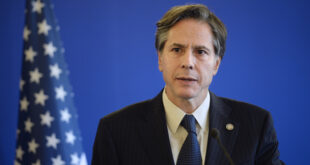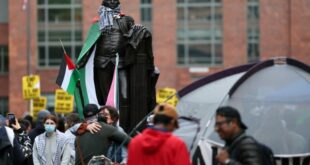Royal Family is far from the first to offer handout images to the media — or edit them.

How can you know if a photo is real?
That’s a question media outlets are facing with renewed scrutiny after two images released by Kensington Palace were found to have been digitally altered — the now-infamous photo of Catherine, the Princess of Wales, surrounded by her smiling children; and a 2022 image of Queen Elizabeth with her grandchildren and great-grandchildren. The former was killed by many photo agencies just hours after they published it.
But the Royal Family is far from the only establishment that hands out images to the media. Politicians, businesses, governments, science agencies and the police do it regularly — just to name a few. And the royals are also far from the first to alter an official image.
“The issues around the trustworthiness of photography, photography as a manipulable technology, have existed from the advent of the medium,” Elisabeth Sherman, the senior curator and director of exhibitions and collections at the International Center for Photography in New York, told CBC News’s social team.
The fact that Kensington Palace’s altered photos were picked up by the media — including CBC News — is a good reminder that the idea of handout photos is fraught and should potentially be reconsidered, says Aneurin Bosley, an assistant professor at Carleton University’s school of journalism, who specializes in digital reporting.
The debacle over Catherine’s photo “is really only scratching the surface,” he said.

A search for “handout” in The Associated Press photo database showed 21,519 results on Monday, everything from images of the suspects in Friday’s deadly Moscow bombing provided by Russian authorities, to those of leader Kim Jong-un provided by North Korea.
There were more than 115,000 results on the Reuters database.
Altered photos are a problem for any reporting. But when they are used in “deeper” issues, “when it goes into the politics of war or the politics of running for for election and, disinformation, it’s pretty scary,” said Ken Light, a photojournalist and adjunct journalism professor at the University of California, Berkeley.

Making an AI-generated image takes seconds
CBC News put Pope Francis in a puffer jacket in less than a minute using Photoshop’s new artificial-intelligence feature.
Long history
Photo tampering has a long and storied history. Even the iconic 1860 portrait of Abraham Lincoln is a stitched image of his head on another politician’s body.
Other well-known examples include the famous, purported photo of the Loch Ness monster, first published in The Daily Mail in 1934, and later proved to be fake. In 1945, a Soviet army photographer manipulated two images of Russia’s victory over Germany, adding extra smoke in the background of one, and removing a second watch on the arm of a soldier in another.

There’s the 1970 Kent State University massacre photo — which became a symbol of the turmoil and protests of the time — and which earned photographer John Paul Filo a Pulitzer Prize. But Life magazine altered it by removing a post behind the anguished bystander’s head, according to The New York Times, and that version has been published and republished over the years.

More recently a freelance photographer working for Reuters used Photoshop to add extra smoke and flares to a 2006 photo of the Iraq war. The incident prompted the wire service to tighten its editing procedures.
Light, who has been a freelance photographer for 50 years, has his own experience with tampering. He took a photo of U.S. politician John Kerry at a 1971 peace rally in Long Island, N.Y. When Kerry announced he was running for president in 2004, Light uploaded his photos to an online photo database.
He says a “right wing” graphic designer then downloaded the photo and added a 1972 photo of Jane Fonda, making it appear as if the two were photographed together.
“And, of course, many Republicans and folks on the right, hate Jane Fonda, Hanoi Jane, they called her. And this photo, this phony photo went viral, and people believed it was true,” he said.
The New York Times even picked it up, but ran a followup explaining the photo had been manipulated.
What’s concerning to Light is how easy it is now to manipulate photos.

Royal Family had warnings from previous photo-manipulation instances
Ian Lloyd, a long-time photographer of the Royal Family, notes several past occasions where the public identified edited images of the Royal Family and says that those should have been taken as warnings. But Lloyd suggests this instance may have been meant to avoid spurring on paparazzi hunting for a photo of the Princess of Wales that could lead to a repeat of the tragic incident that resulted in the death of Prince William’s mother.
“Junior high school kids can do it. Many others can manipulate photos. And of course, now we have AI, which is even more dangerous than the ability to do these things in Photoshop. We begin to question what’s real. What’s not real? How do we know?”
Transparency matters
CBC News was among the outlets to that initially published the Mother’s Day photo of Catherine — which had arrived amid rampant speculation about her whereabouts and wellbeing. It had been picked up and distributed by three of the wire services to which CBC News subscribes: Reuters, The Associated Press and Getty Images.
CBC News later pulled the image, replacing it with one the Prince and Princess of Wales posted on X, and explained that the other had been manipulated.
“The vast majority of images published by CBC News are taken by our own journalists or provided by news partners [like The Canadian Press and Reuters] who we trust to apply the same rigorous standard of accuracy,” said CBC spokesperson Chuck Thompson.
“There are occasions when we publish images provided by a third party that is not a trusted news partner, however we always make clear to the audience why the image was used and where it came from,” he added.

“That said, we refrain from publishing it if we have any indication that the image is not authentic. The source is always clearly indicated.”
It’s important for media organizations to be transparent about how they verify photos, and about the entire reporting process, says Felix Simon, a communication researcher at the Oxford Internet Institute at the University of Oxford. In an age of disinformation and distrust, we need to show how we establish what’s real, he says.
It’s a way of saying: “This is why you can trust us, and this is why you should trust as an institution or as an institution in the business of producing trustworthy factual information,” he said.
Bosley, with Carleton University, says the media has always been skeptical of handout photos, but the demand for information about notable people is high, putting added pressure on news agencies to provide it.
That said, the media should always question the motivations behind any photo coming from an institution — any institution, Bosley says.
“Why should we trust anything?”

ABOUT THE AUTHOR

Natalie Stechyson is a senior writer and editor at CBC News. She’s worked in newsrooms across the country, including the Globe and Mail, Postmedia News, Calgary Herald and Brunswick News. Before joining CBC News, she was the Parents editor at HuffPost Canada, where she won a silver Canadian Online Publishing Award.
*****
Credit belongs to : www.cbc.ca
 Atin Ito First Filipino Community Newspaper in Ontario
Atin Ito First Filipino Community Newspaper in Ontario






